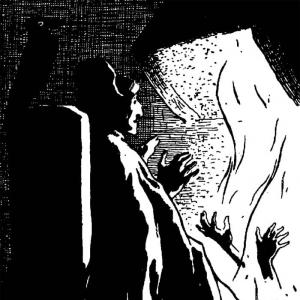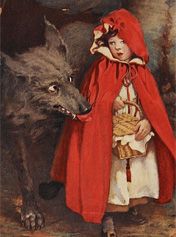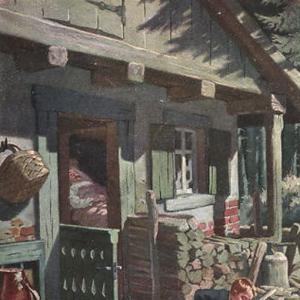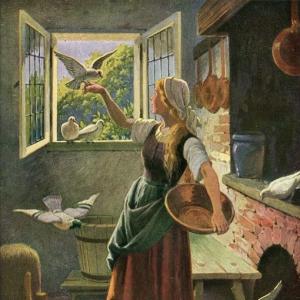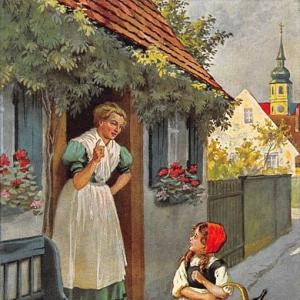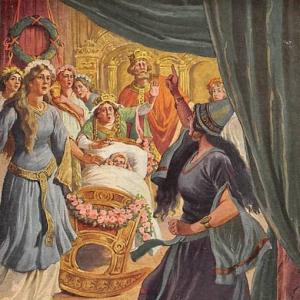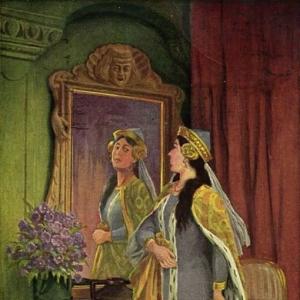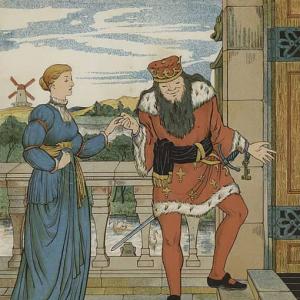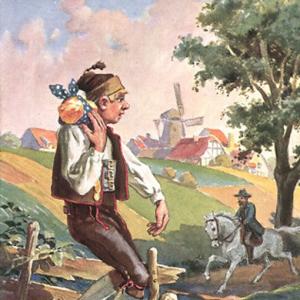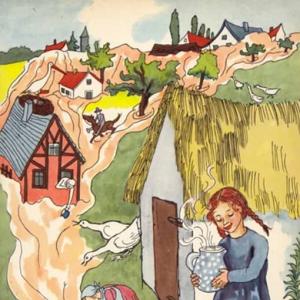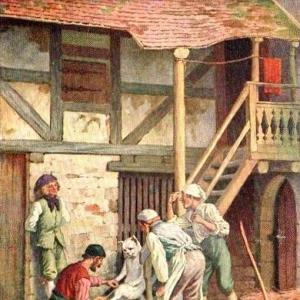Reading time: 7 min
In a poet’s study, somebody made a remark as he looked at the inkstand that was standing on the table: „It’s strange what can come out of that inkstand! I wonder what the next thing will be. Yes, it’s strange!“
„That it is!“ said the Inkstand. „It’s unbelievable, that’s what I have always said.“ The Inkstand was speaking to the Pen and to everything else on the table that could hear it. „It’s really amazing what comes out of me! Almost incredible! I actually don’t know myself what will come next when that person starts to dip into me. One drop from me is enough for half a piece of paper, and what may not be on it then? I am something quite remarkable. All the works of this poet come from me. These living characters, whom people think they recognize, these deep emotions, that gay humor, the charming descriptions of nature – I don’t understand those myself, because I don’t know anything about nature – all of that is in me. From me have come out, and still come out, that host of lovely maidens and brave knights on snorting steeds. The fact is, I assure you, I don’t know anything about them myself.“
„You are right about that,“ said the Pen. „You have very few ideas, and don’t bother about thinking much at all. If you did take the trouble to think, you would understand that nothing comes out of you except a liquid. You just supply me with the means of putting down on paper what I have in me. That’s what I write with. It’s the pen that does the writing. Nobody doubts that, and most people know as much about poetry as an old inkstand!“
„You haven’t had much experience,“ retorted the Inkstand. „You’ve hardly been in service a week, and already you’re half worn out. Do you imagine you’re the poet? Why, you’re only a servant. I have had a great many like you before you came, some from the goose family and some of English make. I’m familiar with both quill pens and steel pens. Yes, I’ve had a great many in my service, and I’ll have many more when the man who goes through the motions for me comes to write down what he gets from me. I’d be much interested in knowing what will be the next thing he gets from me.“
„Inkpot!“ cried the Pen.
Late that evening the Poet came home. He had been at a concert, had heard a splendid violinist, and was quite thrilled with his marvelous performance. From his instrument he had drawn a golden river of melody. Sometimes it had sounded like the gentle murmur of rippling water drops, wonderful pearl-like tones, sometimes like a chorus of twittering birds, sometimes like a tempest tearing through mighty forests of pine. The Poet had fancied he heard his own heart weep, but in tones as sweet as the gentle voice of a woman. It seemed as if the music came not only from the strings of the violin, but from its sounding board, its pegs, its very bridge. It was amazing! The selection had been extremely difficult, but it had seemed as if the bow were wandering over the strings merely in play. The performance was so easy that an ignorant listener might have thought he could do it himself. The violin seemed to sound, and the bow to play, of their own accord, and one forgot the master who directed them, giving them life and soul. Yes, the master was forgotten, but the Poet remembered him. He repeated his name and wrote down his thoughts.
„How foolish it would be for the violin and bow to boast of their achievements! And yet we human beings often do so. Poets, artists, scientists, generals – we are all proud of ourselves, and yet we’re only instruments in the hands of our Lord! To Him alone be the glory! We have nothing to be arrogant about.“
Yes, that is what the Poet wrote down, and he titled his essay, „The Master and the Instruments.“
„That ought to hold you, madam,“ said the Pen, when the two were alone again. „Did you hear him read aloud what I had written?“
„Yes, I heard what I gave you to write,“ said the Inkstand. „It was meant for you and your conceit. It’s strange that you can’t tell when anyone is making fun of you. I gave you a pretty sharp cut there; surely I must know my own satire!“
„Inkpot!“ said the Pen.
„Scribble-stick!“ said the Inkstand.
They were both satisfied with their answers, and it is a great comfort to feel that one has made a witty reply – one sleeps better afterward. So they both went to sleep.
But the Poet didn’t sleep. His thoughts rushed forth like the violin’s tones, falling like pearls, sweeping on like a storm through the forest. He understood the sentiments of his own heart. He caught a ray of the light from the everlasting Master.
To him alone be the glory!
 Learn languages. Double-tap on a word.Learn languages in context with Childstories.org and Deepl.com.
Learn languages. Double-tap on a word.Learn languages in context with Childstories.org and Deepl.com.Backgrounds
Interpretations
Adaptions
Summary
Linguistics
„Pen and Inkstand“ is a short story written by the Danish author Hans Christian Andersen (1805-1875). Andersen is best known for his fairy tales, which have been translated into numerous languages and have inspired various adaptations in different forms of media. Some of his most famous tales include „The Little Mermaid,“ „The Ugly Duckling,“ „The Emperor’s New Clothes,“ and „The Snow Queen.“
Hans Christian Andersen was born in Odense, Denmark, in 1805, and he grew up in poverty. Despite his humble beginnings, Andersen had a vivid imagination and a strong desire to become famous. He eventually moved to Copenhagen to pursue a career in the arts. After struggling to find his niche, Andersen turned to writing and found success with his fairy tales.
Andersen’s fairy tales often explore themes of love, beauty, innocence, and human nature, and they frequently feature fantastic elements and moral lessons. He is renowned for his ability to captivate readers with his imaginative storytelling and vivid characters while delivering a deeper meaning or message.
„Pen and Inkstand“ is one of Andersen’s lesser-known stories, but it shares the same elements of wonder and moral lessons found in his more famous works. In this story, Andersen delves into the creative process, the role of the artist, and the importance of humility. As with many of his tales, „Pen and Inkstand“ can be appreciated by both children and adults, offering different levels of meaning and interpretation for each reader.
„Pen and Inkstand“ by Hans Christian Andersen can be interpreted in several ways. Here are a few key interpretations:
Pride and Humility: The tale serves as a reminder of the importance of humility and the dangers of pride. Both the pen and the inkstand are proud of their roles in the creative process and fail to see the bigger picture. They both claim responsibility for the poet’s creations, highlighting the human tendency to take credit for achievements that may be beyond our control. In contrast, the poet’s reflections emphasize humility and the recognition of a higher power that guides and shapes our abilities and accomplishments.
The Creative Process: The story provides a unique perspective on the creative process by giving voice to the tools used in artistic expression. The pen and the inkstand represent different aspects of this process – the inkstand being the inspiration or the raw material, and the pen being the means by which that inspiration is brought to life. The debate between the pen and inkstand serves as a metaphor for the ongoing exploration of where creativity truly originates – from within the artist, the tools they use, or an external source.
The Role of the Artist: Through the metaphor of the violinist and his instruments, Andersen contemplates the role of the artist in their creations. While it is easy for audiences to become captivated by the beauty of the work itself and forget the artist behind it, the story reminds us that the artist is the one who channels and directs the creative force. However, it also emphasizes that artists should remain humble, acknowledging that their talents are gifts from a higher power.
Collaboration and Interdependence: The story subtly addresses the concept of collaboration and interdependence, as both the pen and the inkstand are essential for the poet’s work. This can be extrapolated to the broader context of human endeavors, where individual components, ideas, and talents come together to create something larger and more meaningful. Recognizing the value of each part in a collaborative process can lead to a deeper appreciation of the whole.
Overall, „Pen and Inkstand“ explores themes of pride, humility, creativity, artistic responsibility, and collaboration through a seemingly simple yet profound conversation between the tools of artistic expression.
„The Pen and the Inkstand“ by Hans Christian Andersen has inspired several adaptations and retellings across various media. Here are a few examples.
„The Magic Pencil“ by Eve Titus: This children’s book retells the story of the pen and the inkstand in a slightly different way. In this version, a young boy named Peter receives a magic pencil that can draw anything he imagines. However, the pencil becomes spoiled and arrogant, and Peter must learn to teach it a lesson about humility.
„Inkheart“ by Cornelia Funke: This young adult novel features a protagonist named Meggie who discovers that her father has the ability to bring characters from books to life by reading aloud. However, this power has unintended consequences, and Meggie must navigate a world where fictional characters can enter reality. The story’s themes of the power of storytelling and the relationship between the writer and their characters are reminiscent of „The Pen and the Inkstand.“
„The Inkwell and the Quill“ by Elizabeth Grayson: This romance novel retells the story of the pen and the inkstand as a love story between two writers, each represented by the titular objects. The novel explores themes of creativity, collaboration, and the relationship between artists and their craft.
„The Ink and the Pen“ by You Jin: This short animated film reimagines the story of the pen and the inkstand as a conflict between two characters in a hand-drawn animation. The film explores themes of collaboration, creativity, and the relationship between the animator and their tools.
Overall, „The Pen and the Inkstand“ has inspired a variety of adaptations that explore different aspects of the original story’s themes and ideas.
„Pen and Inkstand“ is a fairy tale by Hans Christian Andersen that takes place in a poet’s study, where an inkstand and a pen engage in a debate about their importance in the creative process. The inkstand boasts about the extraordinary creations that emerge from it, like the emotions, characters, and scenes it helps the poet bring to life on paper. However, the pen claims that it’s the one that truly writes and transforms thoughts into words, while the inkstand merely provides the liquid to make it possible.
One evening, after attending a concert, the poet returns home, inspired by the performance of a skilled violinist. The music produced by the violinist evoked a range of emotions and sensations, from the gentle murmur of water drops to a storm raging through a forest. The violin and bow seemed to play effortlessly, making it easy for the audience to forget the masterful musician behind them. Reflecting on this, the poet writes an essay titled „The Master and the Instruments,“ musing on the idea that humans are mere instruments in the hands of a higher power, to whom all the glory should be given.
When the poet leaves the room, the pen and inkstand continue their argument, each believing they were being praised in the essay. The pen thinks the inkstand should realize that the words were meant to mock its vanity, while the inkstand believes the satire was aimed at the pen. Satisfied with their witty comebacks, they both fall asleep, while the poet remains awake, filled with inspiration and a deep understanding of the true source of creativity. The story concludes by reinforcing the message that all glory should be attributed to the divine force that guides artistic expression.
Hans Christian Andersen’s „The Pen and the Inkstand“ is a fairy tale that personifies objects in a poetic study to explore themes of artistic creation, ego, and divine inspiration. Through its characters and narrative, the story provides a rich landscape for linguistic analysis.
Characters and Personification
The tale anthropomorphizes the inkstand and pen, granting them voices, opinions, and personalities.
The Inkstand: embodies an inflated sense of self-importance, believing it is central to the creative process.
In contrast, the Pen: sees itself as the primary tool of creation, dismissing the inkstand’s contributions. This dialogue underscores the tension between different components of the creative process, paralleling human tendencies to claim sole credit for collaborative efforts.
Dialogue and Tone
The story utilizes a conversational tone, often characterized by playful banter and sarcasm. The quips exchanged between the Inkstand and the Pen—such as „Inkpot!“ and „Scribble-stick!“—use everyday language to ground the fantastical elements of personified objects. This light-hearted discourse contrasts with the depth of the underlying theme, offering an accessible and engaging exploration of creativity and pride.
Thematic Exploration
A significant theme is the notion of artistic pride versus humility: . The Poet, representing the true creator, ultimately illustrates the folly of both the inkstand’s and pen’s pride by attributing all artistic inspiration to a higher, divine power. The Poet’s reflections, culminating in the essay „The Master and the Instruments,“ convey Andersen’s message that human beings are merely vessels for greater forces, emphasizing humility and perspective in creative pursuits.
Symbolism
The Inkstand and Pen: Symbolize different aspects of the creative ego. Their argument highlights how each element of creation (or tool) tends to overestimate its role in the final artistic product.
The Violinist’s Performance: Mirrors the creative process and serves as an analogy for the relationship between an artist and their tools, suggesting that the beauty of creation often outshines the means by which it is achieved.
Irony and Satire
Irony is woven throughout the tale, particularly in how both the Pen and the Inkstand fail to recognize their interdependence and insignificance without the Poet’s guiding hand. The satirical edge is evident as the Inkstand attempts to mock the Pen, though both are unaware of their lesser status in the creative hierarchy.
Conclusion and Moral
The fairy tale concludes with a moral reflection on the nature of creativity and humility. While the Inkstand and Pen sleep, satisfied with their exchanges, the Poet remains awake, contemplating deeper truths and recognizing the ultimate supremacy of the divine in the act of creation. Andersen leaves readers with a reminder of human limitations and the importance of attributing true glory to higher powers beyond oneself.
In sum, „The Pen and the Inkstand“ is a layered narrative that uses personification, irony, and symbolism to delve into the dynamics of artistic pride and the humility owed to greater forces, all wrapped in Andersen’s characteristic whimsy and moral insight.
Information for scientific analysis
Fairy tale statistics | Value |
|---|---|
| Translations | DE, EN, ES, FR, IT |
| Readability Index by Björnsson | 26 |
| Flesch-Reading-Ease Index | 82.1 |
| Flesch–Kincaid Grade-Level | 4.9 |
| Gunning Fog Index | 7.9 |
| Coleman–Liau Index | 8.9 |
| SMOG Index | 8.7 |
| Automated Readability Index | 4.5 |
| Character Count | 4.630 |
| Letter Count | 3.546 |
| Sentence Count | 68 |
| Word Count | 846 |
| Average Words per Sentence | 12,44 |
| Words with more than 6 letters | 115 |
| Percentage of long words | 13.6% |
| Number of Syllables | 1.121 |
| Average Syllables per Word | 1,33 |
| Words with three Syllables | 62 |
| Percentage Words with three Syllables | 7.3% |

 Facebook
Facebook  Whatsapp
Whatsapp  Messenger
Messenger  Telegram
Telegram Reddit
Reddit